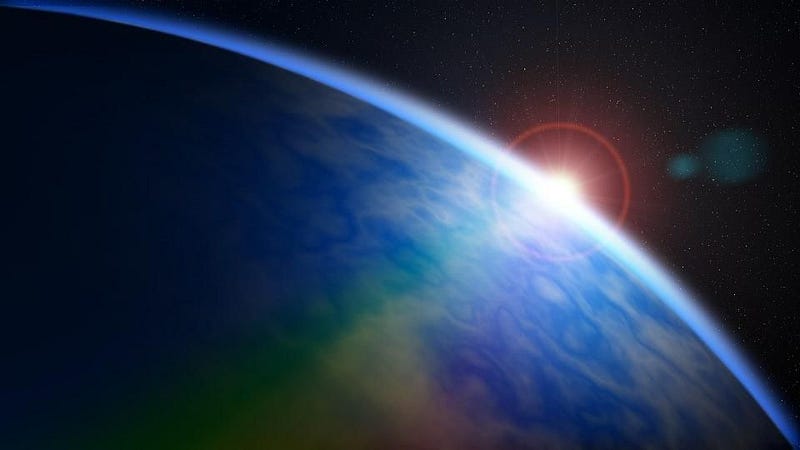What If It’s Just Us?

We assume that life is ubiquitous in the Universe. But what if it’s just us?
When it comes to the question of extraterrestrial life, humans optimistically assume the Universe is prolific. After all, there doesn’t appear to be anything particularly special about Earth, and life not only took hold here on our world, but evolved, thrived, became complex and differentiated, and then intelligent and technologically advanced. If the same ingredients are everywhere and the same rules are at play, wouldn’t it be an awful waste of space if we’re alone?
But this is not a question that can be answered by appeals to either logic or emotion, but by data and observation alone. While our investigations have revealed the existence of an enormous number of candidate planets for life, we have yet to find one where intelligent aliens, complex life, or even simple life is known to exist. In all the Universe, humanity may truly be alone.

A generation ago, we knew almost nothing about the planets that exist in the Universe beyond our own Solar System. We knew then — as we do now — that there were hundreds of billions of stars in our Milky Way alone, and thought there were hundreds of billions of galaxies throughout the visible Universe. (We know now that there are more like 2 trillion galaxies throughout our observable Universe.)
All told, there are some 10²⁴ stars in the observable Universe. For a very long time, all we could do was speculate as to whether they had planetary systems around them. We didn’t know what fraction of planets were likely to be Earth-sized; we didn’t know what their orbital distances from their stars would be; we didn’t know how common or rare a world like ours might be.
But over the past 30 years, the landscape of exoplanet science has changed irrevocably.

A combination of direct imaging, radial velocity studies, and measurements of transiting exoplanets have revolutionized what we know is out there. Led by NASA’s now-defunct Kepler mission, we’ve learned so much about what’s out there, including that:
- somewhere between 80–100% of stars have planets or planetary systems associated with them,
- approximately 20–25% of those systems have a planet in their star’s “habitable zone,” or the right location for liquid water to form on their surface,
- and approximately 10–20% of those planets are Earth-like in size and mass.
A substantial fraction of stars out there (around 20%) are either K-, G-, or F-class stars, too: Sun-like in mass, luminosity, and lifetime. Putting all these numbers together, there are around 10²² potentially Earth-like planets out there in the Universe, with the right conditions for life on them. In our Milky Way alone, there may be billions of planets with Earth-like chances for life.

But knowing there’s a bird in the bush is not the same as having one in your hand. Similarly, having a planet with the raw ingredients for life and similar conditions to what we had in the early days of Earth doesn’t necessarily guarantee that life will arise on such a planet. Even if life does arise, what are the odds that it will persist, thrive, and become complex and differentiated? And beyond that, how often does it become intelligent and then technologically advanced?
Given all the events and circumstances that have transpired over the past 4.5 billion years — including the evolutionary twists and turns that occurred as the result of seemingly random processes — it’s safe to say that the exact way life unfolded on Earth is cosmologically unique. But what about life, complex life, or technologically advanced life at all?

If we demand that we be scientifically honest and scrupulous, and look at the evidence without judgment in either optimistic or pessimistic directions, this is truly the limit of what we can say as far as the odds of life elsewhere are concerned. Our hopes and fears about the existence of aliens, of being cosmically alone, or any other point on the spectrum of possibilities have no decisive evidence to support or refute them.
While it may be exciting to speculate about thousands of spacefaring civilizations in the Milky Way right now, or intelligent aliens modifying their cosmic backyard or deliberately hiding from Earth, there is simply no evidence for this. Hypothesizing a slew of possibilities that haven’t been ruled out might be a clever exercise that will someday lead to greater knowledge, but we can say nothing definitive about them today.

All we know is that, if a planet was formed similar to Earth in the distant past, there are three big steps that must have occurred in order to get a recognizably advanced civilization like our own.
1. Life must have somehow arisen from non-life. This is the problem of abiogenesis, or the origin of life from non-living precursor molecules. To go from the raw ingredients associated with organic processes to something that’s classified as life, which means it has a metabolism, responds to external stimuli, grows, adapts, evolves, and reproduces, is the first big step.
It occurred at least once, more than 4 billion years ago, on our world. Has it occurred elsewhere in our Solar System? In our galaxy? In the Universe? We have no idea how frequently, out of the multi-billion planetary candidates in our galaxy or out of the 10²² candidates in the visible Universe, this may have occurred.

2. Life must have thrived and evolved to become multicellular, complex, and differentiated. For billions of years, life on Earth was single-celled and relatively simple, with copying errors from one generation to the next providing the overwhelming amount of variation in organisms. Wherever resources abound, the simplest organisms to first make use of them fill that ecological niche. Under most circumstances, they find a way to persist.
It’s only when something changes, such as resource availability, the survivability of the environment, or from competition, that extinctions occur, leaving open the possibility for a new organism to rise to prominence. Extinction events and selection pressures gave rise to many critical evolutionary steps on Earth: DNA absorption, eukaryotic organisms, multicellularity, and sexual reproduction, among others. This could be an inevitable occurrence on a planet with life, or it could be an ultra-rare event that happened to take place many times on Earth. We don’t know.

3. Intelligent life must have evolved, with the right traits to also become a technologically advanced civilization. This may be the step with the greatest uncertainty of all. It’s been over 500 million years since the Cambrian explosion, and it’s only over the past few hundred years that life on Earth has achieved the technologically advanced state that an extraterrestrial observer would recognize as a sign of intelligent life.
We can broadcast our presence to the Universe; we can reach out beyond our home world with space probes and crewed space programs; we can look and listen for other forms of intelligence in the Universe. But we have no known instances of success on this front in our Universe beyond our own planet. Life like us could be common, or we could be the only example within the limits of our observable Universe.

The notion that we can quantify the odds that a form of intelligent life arises in our Universe based on the scientific knowledge we have today is old: it goes back to the mid-20th century at least. Enrico Fermi, whom the famous Fermi Paradox is named after, posited that such estimates led to the notion that intelligent life in the Universe should be common, so, then, where is everyone?
The Drake equation was a famous way to parameterize our ignorance, but we still remain ignorant about the presence of alien life and alien intelligence. Hypothesized solutions have included:
- that they’re there, but we aren’t listening properly,
- that intelligent life self-destructs too quickly to maintain a technologically advanced state for very long,
- that intelligent life is common but usually chooses isolation,
- that Earth is purposely excluded,
- that interstellar transmission or travel is too hard,
- or that aliens are already here, but choose to remain hidden from us.
These proposed solutions usually leave out the most obvious option: that one of the three above steps are hard, and that when it comes to intelligent life in all the Universe, it’s just us.

Our scientific discoveries have led us to a remarkable point in the quest for knowledge about our Universe. We know how big the Universe is, how many stars and galaxies are in it, and what fraction of stars are Sun-like, possess Earth-sized planets, and have planets in orbits which are potentially habitable. We know the ingredients for life are everywhere, and we know how life evolved, thrived, and gave rise to us here on Earth.
But how did life arise to begin with, and how likely is a planet to develop life from non-life? If life does arise, how likely is it to become complex, differentiated, and intelligent? And if life achieves all of those milestones, how likely is it that it becomes spacefaring or otherwise technologically advanced, and how long does such life survive if it arises? The answers may be out there, but we must remember the most conservative possibility of all. In all the Universe, until we have evidence to the contrary, the only example of life might be us.
Ethan Siegel is the author of Beyond the Galaxy and Treknology. You can pre-order his third book, currently in development: the Encyclopaedia Cosmologica.





